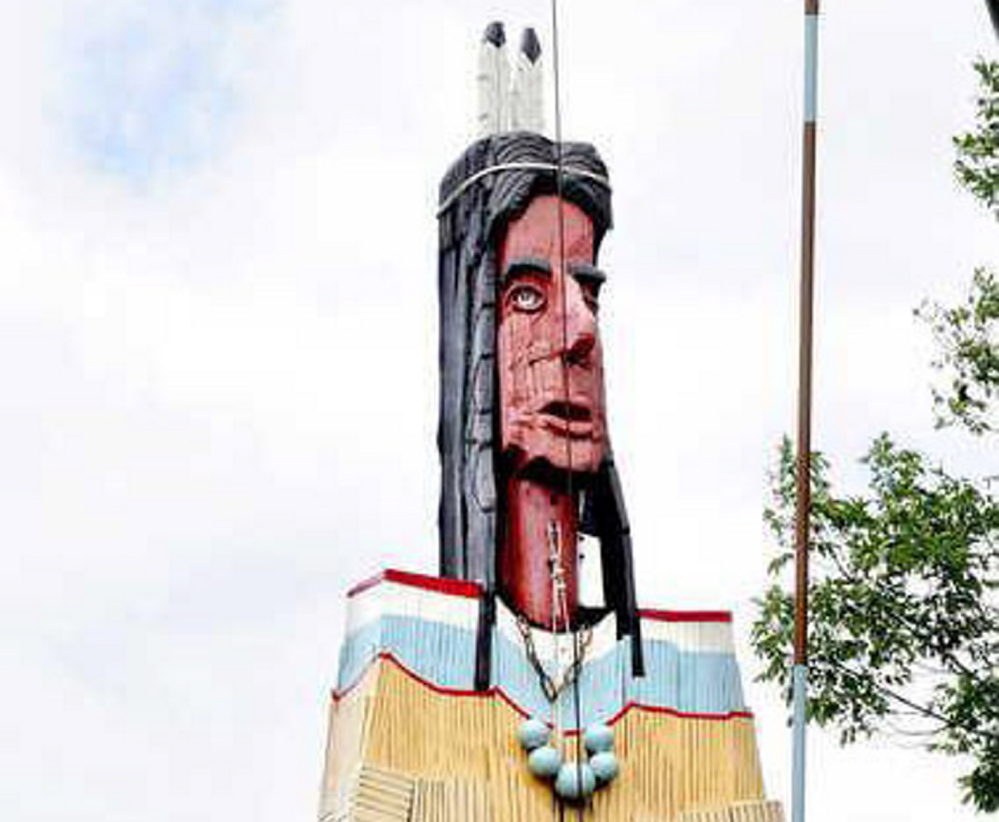SKOWHEGAN — If Maine artist Bernard Langlais could see his 62-foot Skowhegan Indian sculpture now, he would see a statue looking just as it did when it originally was erected and dedicated in 1969.
The statue will be rededicated Saturday after a painstaking restoration in which even the paint was scientifically mapped in a laboratory to match the original colors used by Langlais, who died in 1977.
“I think he would be very pleased at what we have accomplished here,” said Stephen Dionne of Skowhegan, whose construction company restored the Indian. “I think that he would be very, very pleased that it’s being preserved and will last many, many years to come.”
Dionne said the project is an important part in remembering the region’s past by recognizing the Indians who lived in the region and who named the area along the Kennebec River Skowhegan — a place to watch — referring to the waterfalls where Abenakis watched the river to spear spawning salmon and other sea-run fish for food for the winter.
The rededication of the Skowhegan Indian is set for 2 p.m. Saturday at the base of the sculpture off High Street. The event will feature speakers who over the last 10 years have helped raise the $65,000 it took to do all the restoration work, along with Hanna Blunt, from the Colby Museum of Art, where many of Langlais’ pieces are on exhibit. There also will be a drum circle and a free exhibit of Langlais art in the Renaissance Center on Water Street.
Members of Maine’s Indian nations have been invited to attend the rededication of the statue originally created by Langlais as a tribute to Maine’s Indians.
There will be live music on stages in several locations around town as Skowhegan also observes its first Celebration Of The Arts festival with music, art displays and entertainment beginning at 9 a.m. and running until 9:30 p.m.
Cory King, executive director of the Skowhegan Area Chamber of Commerce, which owns the sculpture, said the years of work by many people to restore the Indian finally has paid off.
“The Indian is done and it’s the final steps of a 10-year journey that started back with the fundraising effort in 2004,” King said. “Thanks to Main Street Skowhegan partnering with us, we were able to get some grant funds.”
The money for the restoration was raised through efforts by the Chamber, the Maine Community Foundation, the Maine Arts Commission, the Jackson Family Fund, Skowhegan taxpayers at last year’s annual town meeting, private donations and Main Street Skowhegan, a nonprofit downtown revitalization group.
“The original money that came in — some of it was from cribbage tournaments and from bake sales and from individual donations,” King said. “There was a woman from California who sent us $1,000 — she was the valedictorian of the Skowhegan (High School) class of 1954. It’s not just one person or two people or one grant foundation that did this. This was really hundreds of people who came to this Indian over the last 10 years.”
Fundraising by Main Street Skowhegan began in earnest when Jennifer Olsen was executive director a couple of years ago and continued under current director Dugan Murphy.
“The rededication of the Skowhegan Indian sculpture is an opportunity as a community to celebrate our collective success in revitalizing a historic landmark and making it accessible for future generations,” Murphy said “We raised $65,000 — that’s a big deal.”
Now that the sculpture is restored, Murphy said, Main Street Skowhegan is building a park for viewing the sculpture, which will include seating, a walkway and educational landscaping relevant to traditional Abenaki culture.
In terms of the overall extensive Langlais art collection, the Skowhegan Indian is the largest and the best known piece, King said.
The Indian was made from carved sections of hemlock over a period of three years. Langlais, who grew up in Old Town, was a student and teacher at the Skowhegan School of Painting & Sculpture.
His wife, Helen, was a Skowhegan native.
A portion of the artist’s collection of about 3,500 pieces was willed to Colby College in Waterville by his wife upon her death in 2010. Colby then donated the collection and the Langlais estate grounds in Cushing to the Wisconsin-based Kohler Foundation, a group focused on art preservation. Many of those works are now at locations around Maine — part of the Langlais Trail.
Dionne, whose company began restoration work in July, said paint from each section of the sculpture was scraped and samples were sent to Williamsburg, Va., where a specialist performed a microscopic analysis of each sample. The paint samples were dissolved with chemicals to see what the actual pigments were.
“These are the colors that she told us were the original colors,” Dionne said. “We’re back to the original colors now.”
The paint, about 19 gallons, was donated for the project by the Benjamin Moore Co., which learned of the project through the Skowhegan office of Hammond Lumber Co.
Dionne, who has been involved with the Indian restoration project since 2006, said the Indian’s original spear and wooden weir, or fishing net, has been restored to the sculpture, as have parts of the Indian left hand, right arm and one entire leg that was nearly destroyed by ants. He said both feet of the statue — each weighing 140 pounds — are new, as well.
Dionne said his company used 42 lineal feet of galvanized bolts to secure the sculpture, along with stainless steel guy wires. Workers used 150 pounds of lead flashing, 140 pounds of stainless steel wire mesh inside the sculpture to keep squirrels and other animals out, and 740 pounds of epoxy grout.
Doug Harlow — 612-2367
Twitter: @Doug_Harlow
Send questions/comments to the editors.




Comments are no longer available on this story